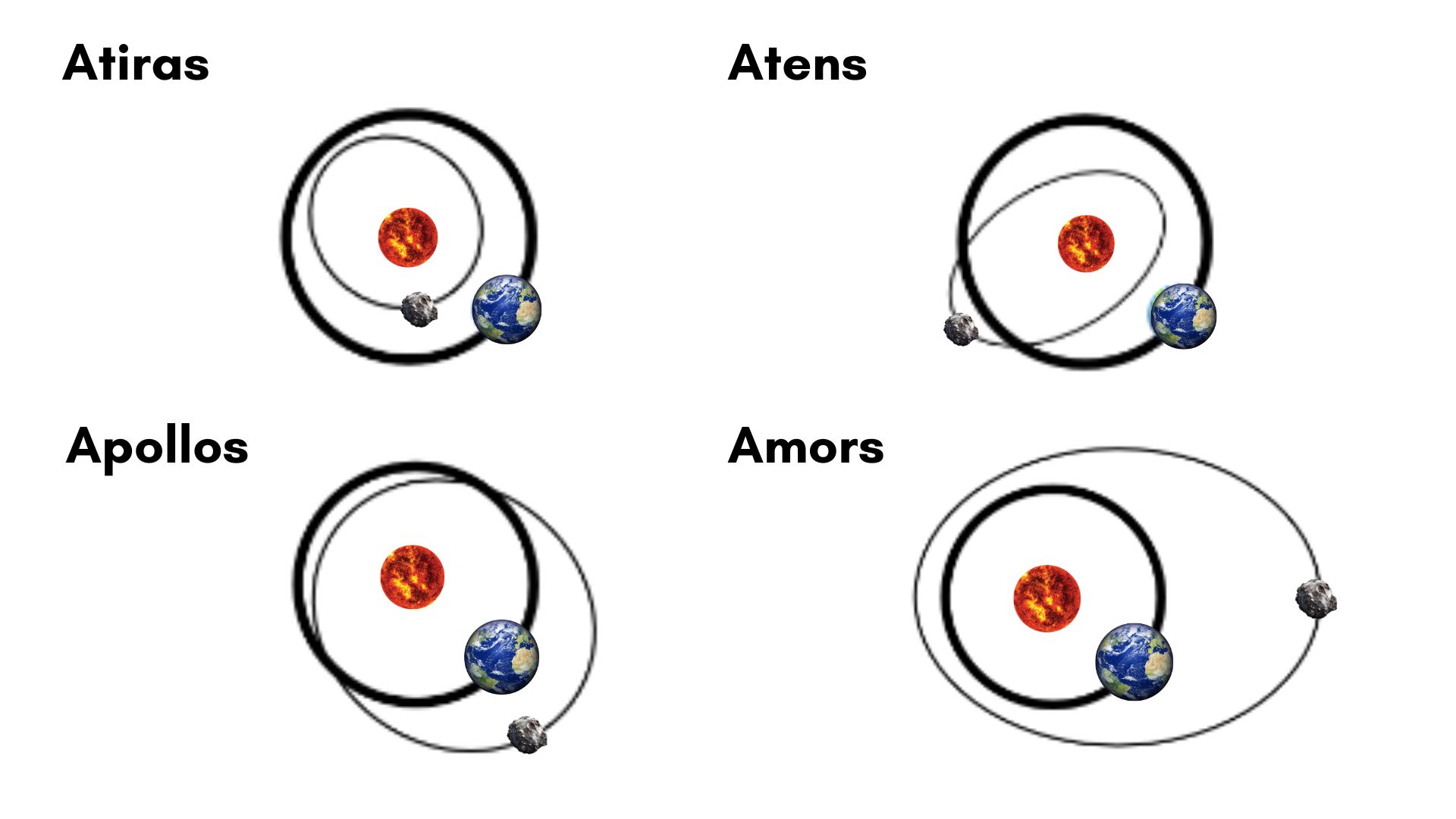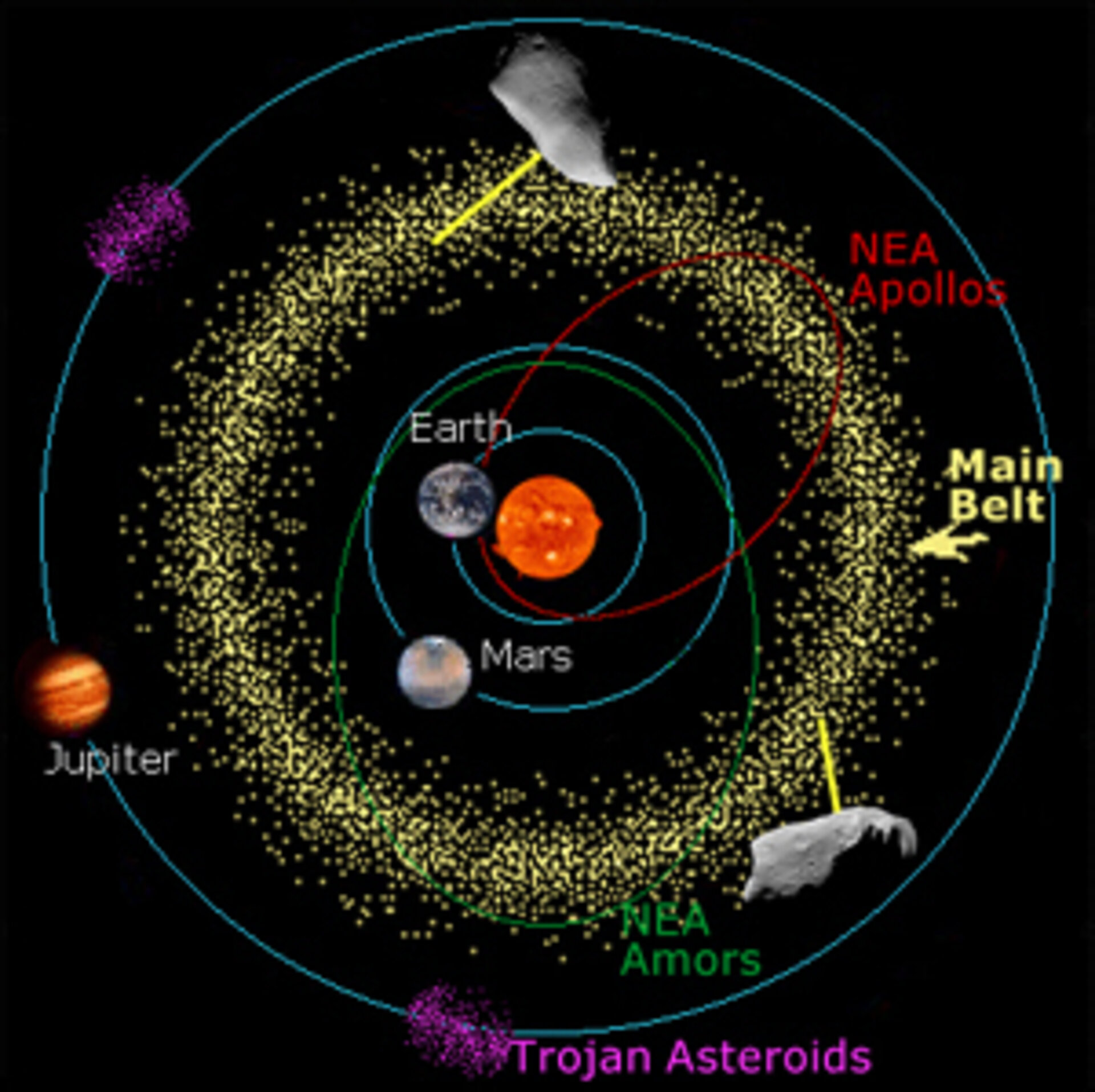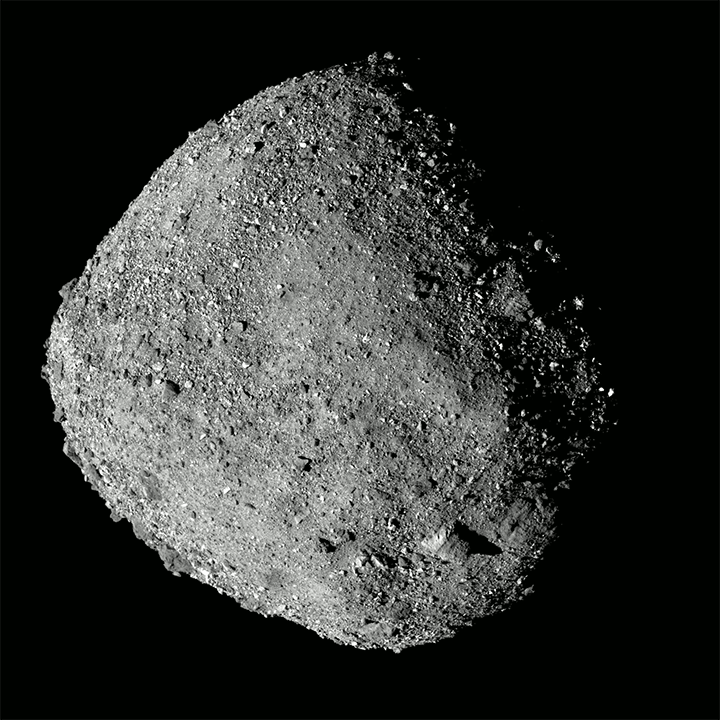
NASA defines near-Earth objects (NEO) as asteroids or comets with orbits that bring them within 120 million miles (195 million kilometers) of the sun, meaning they are close to Earth's orbit. The vast majority of these NEOs are asteroids, or near-Earth asteroids (NEAs).
There are over 600,000 known asteroids in the solar system, and over 20,000 of these are NEAs, according to the European Space Agency (ESA). Most of the rest are located in the main asteroid belt between Mars and Jupiter. NEAs are thought to make their way out of the asteroid belt and toward Earth's orbit as they are nudged by the gravity of other solar system bodies. The majority of NEOs range from about 10 feet to 25 miles (3 meters to 40 km) wide, according to NASA.
Related: Planetary defense: Protecting Earth from space-based threats
Types of near-Earth asteroids

NEAs are divided into four significant families based on their orbital parameters: Atiras, Atens, Apollos and Amors.
Atiras are NEAs with orbits that are contained entirely within Earth's orbit. They are named after the asteroid 163693 Atira.
Atens are NEAs that cross Earth's path and whose orbits have semimajor axes smaller than that of Earth's orbit around the sun. They take their name from the asteroid 2062 Aten.
Apollos are NEAs that cross Earth's orbit with a semimajor axis larger than that of our planet. They get their name from the asteroid 1862 Apollo.
Amors are Earth-approaching NEAs with orbits that bring them within the orbit of Mars but do not bring them within the orbit of Earth. Their name comes from the asteroid 1221 Amor.
One concerning category of NEAs are so-called potentially hazardous asteroids (PHAs), which the NASA Jet Propulsion Laboratory's Center for Near-Earth Object Studies (CNEOS) defines based on an asteroid's potential to make a threatening close approach to Earth. Specifically, this concerns the object's "minimum orbit intersection distance (MOID)" — the distance an asteroid is from Earth when its orbit crosses or touches the orbit of our planet — and the brightness of the object if it were located at the same distance from Earth as Earth is from the sun (1 astronomical unit, or AU), known as absolute magnitude.
PHAs must have a MOID of around 4.65 million miles (7.48 million km), or 0.05 AU, and an absolute magnitude of 22 or brighter. Because MOID is used to calculate the diameters of asteroids, bodies smaller than 460 feet (140 m) wide are not classified as PHAs, no matter how close they come to Earth, per CNEOS.
Only a small fraction of NEAs are considered potentially hazardous, but their potential threat to our planet means that space agencies across the globe are working hard to identify and track these dangerous space rocks.
Near-Earth asteroids FAQs
What is a near-Earth asteroid?
NASA defines a near-Earth asteroid as an asteroid with an orbit that brings it to within 120 million miles (195 million km) of the sun. This allows these space rocks to pass through Earth's neighborhood in the solar system.
Is an asteroid going to hit Earth in 2029?
For almost two decades, the asteroid Apophis sat atop NASA's Sentry risk table as the asteroid most likely to impact Earth in the next 100 years. But now that the orbit of the asteroid, which was discovered in 2004, has been better constrained, astronomers know it won't hit Earth for at least 100 years.
That means that when Apophis skims Earth on April 13, 2029, it will not hit our planet. Passing by at around 19,000 miles (31,000 km), the 1,100-foot-wide (340 m) asteroid will come closer than some satellites and should be so bright that over 2 billion people in the Eastern Hemisphere will be able to witness it with the naked eye.
Will Bennu hit Earth?
With Apophis falling in the Sentry risk table rankings, the next-riskiest asteroid is Bennu. Yet NASA estimates that there is no chance that Bennu will hit Earth for at least a century.
When Bennu makes a close approach to our planet on Sept. 24, 2182, there is a 0.037% — or 1 in 2,700 — chance that the 1,600-foot-wide (488 m) asteroid will strike our planet.
How do we track near-Earth asteroids?

A great deal of asteroid tracking data is collected by NASA-funded observatories, such as the University of Hawaii's Panoramic Survey Telescope and Rapid Response System (Pan-STARRS), the Catalina Sky Survey, and the University of Hawaii's Asteroid Terrestrial-impact Last Alert System (ATLAS).
Data regarding the positions of NEAs around Earth are gathered by the International Astronomical Union's Minor Planet Center (MPC). The MPC handles the identification, designation and orbit computation for these objects and then announces discoveries to space agencies such as NASA.
Once a potential NEA is discovered, the object is followed up on by projects such as NASA's space-based Near-Earth-Object Wide-Field Infrared Survey Explorer (NEOWISE) telescope, along with planetary radar projects, like JPL's Goldstone Solar System Radar Group.
The science of NEAs falls to several bodies within NASA. For instance, CNEOS characterizes the orbits of all currently known NEOs and then predicts their close approaches to Earth. With this information, CNEOS can make comprehensive impact hazard assessments, which are supplied to NASA's Planetary Defense Coordination Office in Washington, D.C.
Performing long-term assessments and predicting PHAs' orbits with the Sentry impact monitoring system, CNEOS also maintains the Scout system, which monitors potential NEAs to assess possible impacts. After an NEA is detected but before it is confirmed, it is placed on the Minor Planet Center's NEO Confirmation Page (NEOCP). The Scout system then monitors these candidate NEAs over the coming days and weeks to assess their trajectory and possible impacts.
Once the NEA is confirmed, it is removed from the NEOCP. Then, all of the data are compiled in the Sentry risk table , which lists the NEAs with the greatest probability of impacting Earth over the next 100 years. This is probability-based, because it takes many years of observations to constrain the orbit of an NEA, and even then, there are measurement uncertainties.
What are the dangers of near-Earth asteroids?

Earth is under constant bombardment from space rocks. NASA estimates that around 48.5 tons (44 metric tons) of material falls to Earth every day, most of which burns up in the atmosphere and occasionally creates "shooting stars." According to NASA, space rocks smaller than about 82 feet (25 m) will most likely burn up as they enter Earth's atmosphere and thus cause little or no damage.
Earth's geological history is a stark reminder, however, that larger asteroids can make it through the atmosphere and that impacts by large space debris can have disastrous consequences. This is particularly evident in the case of the asteroid that caused the Cretaceous-Tertiary extinction event 66 million years ago, which eliminated 80% of plant and animal species on Earth, including the nonavian dinosaurs.
Because of the destructive capacity of asteroids, CNEOS has a role in addition to monitoring real asteroids around Earth: It conducts hypothetical asteroid impact exercises, which have given us an idea of the kind of devastation that would result from a collision within an NEA.
Fortunately, NASA suggests that the larger an asteroid is, the less likely it is to impact Earth. While around 100 tons (90 metric tons) of dust- and sand-size particles reach Earth every day, a roughly car-size asteroid strikes Earth's atmosphere around once a year, burning up and resulting in a fireball over Earth.
Around every 2,000 years, Earth encounters an asteroid around the size of a football field — about 330 feet (100 m) wide. The significant destruction caused by such an impact would be localized, with the asteroid likely vaporizing just over Earth's surface and destroying buildings within a radius of 9 miles (14 km) and shattering windows within a radius of around 60 miles (100 km). More widespread damage could be caused by seismic tremors and rock hurled into the atmosphere by such an impact.
During a CNEOS asteroid impact exercise in April 2023, NASA researchers revealed the damage that would result from impacts of larger asteroids.
For example, a 1,000-foot-wide (300 m) asteroid could represent destruction on a continental scale, releasing as much energy as the detonation of 2,000 megatons of TNT — equivalent to 133,000 times the estimated energy released by the bomb that destroyed Hiroshima at the end of World War II. Earth experiences an impact from such a body around every 70,000 years.
The devastation would grow significantly for a 2,000-foot-wide (600 m) asteroid. An impact with an asteroid this size would border on global catastrophe, releasing as much as 20,000 megatons of energy. This means a doubling in asteroid size has resulted in an increase in devastation power by a factor of 10. Fortunately, asteroids of this size are predicted to hit Earth just once every 200,000 years or so.
For a 3,330-foot-wide asteroid (about three times as tall as the Eiffel Tower), an impact scenario as calculated by CNEOS would become dire. Indeed, asteroids of this size are considered potential "planet killers." A planet-killer impact would release around 100,000 megatons of energy — equivalent to 6.6 million detonations of the Hiroshima nuclear blast. These impacts are estimated to occur around once every 700,000 years.
The dinosaur-killing asteroid, known as the Chicxulub impactor, had an estimated width of 6.2 miles (10 km) and released around the same amount of energy — 720 megatons of TNT — when it hit what is now the Yucatán Peninsula in Mexico at around 45,000 mph (72,000 km/h). Asteroids above 3 miles (5 km) in width, like the Chicxulub impactor, are predicted to strike Earth once every 30 million years.
According to the University of California, Berkeley, size isn't the only characteristic that affects how much damage an NEA would cause if it hit Earth. Other factors include the asteroid's composition (for example, is it a loose rubble pile or a whole lump of iron?) as well as the angle and speed of the impact and whether the asteroid hits Earth on land or in the ocean.
Additional resources
If you're worried about potential NEA encounters, you can keep an eye on NASA's Sentry risk table. If you'd like to estimate the damage that could result from an asteroid of a specific size and density, the Earth Impact Program, from Imperial College London and Purdue University, is a great resource. It also allows you to input hypothetical impacts on land or water and even vary the depth of water in which the space rock lands. On YouTube, math professor Nils Berglund simulates what would happen if an asteroid struck Earth in the North Pacific Ocean.
Bibliography
NEO Basics, NASA, [Accessed 06/10/23], [https://cneos.jpl.nasa.gov/about/basics.html]
Asteroid Watch: Keeping an Eye on Near-Earth Objects, NASA Jet Propulsion Laboratory, Caltech, [Accessed 06/10/23], [https://www.jpl.nasa.gov/asteroid-watch]
NEO Observations Program, [Accessed 06/10/23], [https://www.nasa.gov/planetary-defense-neoo/]
NEO Earth Close Approaches, [Accessed 06/10/23], [https://cneos.jpl.nasa.gov/ca/]
Space Safety: ESA's Planetary Defence Office, ESA, [Accessed 06/10/23], [https://www.esa.int/Space_Safety/Space_Safety_ESA_s_Planetary_Defence_Office]







